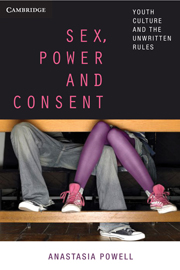7 - Education
Sex, power and consent in schools
Published online by Cambridge University Press: 03 May 2011
Summary
Previous chapters have identified a number of social norms, discourses, or unwritten rules surrounding young people's sexuality that contribute to the persistence of Gen-Y women's experiences of pressured and unwanted sex. It is apparent that this implicit set of rules and the associated meanings attached to love and sex have specific implications for how young people feel able to negotiate consent and safe-sex practices. This remains the case even in online spaces where it has been suggested that gender norms may have less sway. The role of the love relationship for young women, in particular, as the acceptable context for expression of their sexuality, can be associated with pressure to engage in unwanted sex or in sex under unwanted circumstances (such as without the continued use of condoms, when a partner is drunk or drug-affected, or sending a sext message that may then be widely distributed by the receiver). Yet these social norms and gendered discourses are not straightforwardly reproduced or necessarily reflected upon by young people; rather, young people's negotiations of sexual consent reflect an embodied gendered practice: they engage with the field of sexual encounters according to the social rules adopted in their gendered habitus. While, according to Bourdieu, this process of social reproduction is not easily amenable to self-reflection and change, it is nonetheless subject to disruption, which might allow a more reflexive practice.
- Type
- Chapter
- Information
- Sex, Power and ConsentYouth Culture and the Unwritten Rules, pp. 126 - 153Publisher: Cambridge University PressPrint publication year: 2010



